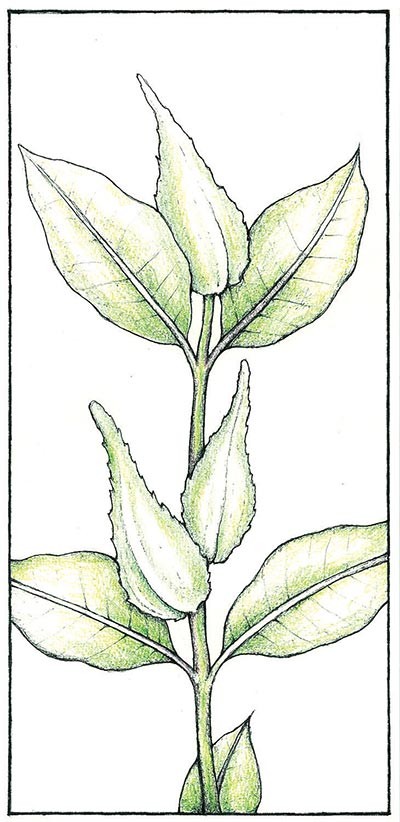All foraging is local. Wild food guides are written for audiences that may stretch across a continent, but the edibility and flavor of plants vary from place to place. The common milkweed is a case study in the local-ness of foraging.
Common milkweed, Asclepias syriaca, with its wide, waxy, entire leaves, is a familiar resident of roadsides, pastures, and vacant lots. Remove a leaf and a milky latex weeps from the wound. In summer, clusters of small, dusk-pink flowers become wrinkled, green, horn-like pods that, in fall, will release seeds on parachutes of silk.
Common milkweed is familiar, but even a cursory consultation of the wild food literature reveals controversy. Depending on which source you consult, it is poisonous or edible, intolerably bitter or not bitter at all.
For starters, it is important to note that the dogbanes (Apocynum sp.), close relatives of milkweed, are too poisonous to eat. So care when identifying milkweed is essential. Dogbanes typically flower at the ends of their branches; in milkweed there’s usually just one stem and the flowers emerge from the leaf bases/axils. Beyond that caution, as I’ve noted before, edibility is usually less of an either/or dichotomy and more of a spectrum. All substances can be harmful in high enough concentrations. So instead of asking whether milkweed is edible, we should ask how edible milkweed is.
The answer depends. All milkweeds contain cardenolides, bitter steroids that protect against leaf-munching insects. How, then, can respected foragers claim that milkweed isn’t poisonous or bitter? First, species matters. The common milkweed (A. syriaca) has lower concentrations of cardenolides than any other milkweed species. In fact, it is the only species safe to forage. Be certain which species you’re collecting. Local weather conditions can also matter; wetter seasons give better flavor. The age of the plant is another factor to consider; younger is better, so forage for milkweed early in the summer. And importantly, location matters. Some patches are less bitter than others. Reportedly, some aren’t bitter at all. Cross-pollination between closely related milkweeds may contribute to a population’s bitterness.
Which brings us back to the original lesson: all foraging is local. Come upon the right patch at the right stage of growth in the right year and milkweed can be delicious with very little preparation. The trick is to taste around. In early summer, look for the small green flower buds. They look like clusters of bright green capers. I prefer to gather them early when they are small. Later in the season, newly opened flowers can be gathered. I boil small numbers of buds or flowers from any good patch for 5 to 10 minutes. If they are bitter, I continue to boil. Good patches may yield a harvest that doesn’t need to be boiled at all and can be eaten after stir frying or baking. Occasionally, I need to boil in two or three waters. My favorite patches require minimal cooking, but cooking always improves flavor. Bitterness is the tongue’s way of detecting the alkaloids and cardenolides, a warning that something is not good for you. If your milkweed is bitter, don’t eat it. Continue cooking until it is palatable.
At that point, you will find milkweed to be a mild vegetable that some compare in flavor to the green bean. It is a great addition to mild dishes that do not mask its flavor. One of my favorites is milkweed macaroni and cheese (see accompanying recipe). And as you do, enjoy knowing that in addition to gathering a fine meal, you have also forged a deeper understanding of the place in which you live.
Milkweed Mac’n Cheese
INGREDIENTS
2 cups milkweed flowers, diced and rinsed
3 cups milk
8 oz. dry pasta – spirals or other chunk y shapes
2 T bsp. flour
1 1/2 cups shredded sharp cheddar cheese
2 T bsp. butter
salt and pepper bread crumbs
Preheat oven to 350 degrees. Boil pasta (in salty water) until al dente. Put milkweed in a pot. Pour boiling pasta water over milkweed and let sit a few minutes. Taste. If still bitter, bring to boil for 5 to 10 minutes. Drain pasta and milkweed. Pour both into an 8x8 baking dish. While pasta is cooking, make sauce. In a saucepan or deep skillet, melt butter. Add flour and cook three minutes, stirring constantly. Add milk. Salt well. Dash with pepper. Stirring frequently, bring to simmer (small bubbles). Remove from heat. Add cheddar and stir. Pour cheese sauce over pasta. Sprinkle casserole with breadcrumbs. Bake until bubbly in the middle – 20 to 30 minutes.


